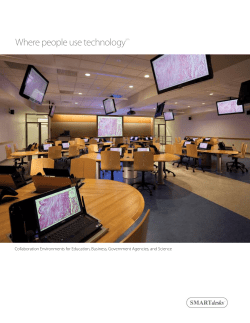
Environment Protection Engineering SCREENING LIFE CYCLE ASSESSMENT
Environment Protection Engineering Vol. 39 2013 No. 3 DOI: 10.5277/epe130304 KATARZYNA GRZESIK-WOJTYSIAK1, GRZEGORZ KUKLIŃSKI1 SCREENING LIFE CYCLE ASSESSMENT OF A LAPTOP USED IN POLAND In recent years, laptops have become very commonly used, causing a significant environmental impact. In Poland about 2 million portable computers are sold every year. Life Cycle Assessment (LCA) is a tool which evaluates environmental impacts associated with a product throughout its life. In this paper, a screening life cycle assessment for a personal computer – Actina laptop, assembled, used and disposed in Poland was performed. Values for eleven impact categories were provided with the application of the Eco-indicator 99 method, expressing the significance of the burden on the environment. For the whole life cycle, the most significant stage is the use phase, due to electricity consumption (over 60% of all environmental impacts) followed by the manufacturing of the product with over 37% of the share. 1. INTRODUCTION In recent years portable personal computers have become more and more popular. Around 109 million laptops were sold worldwide in 2007, while in 2010 – 204 million laptops were shipped [1, 2]. The predictions indicate that worldwide notebook unit shipments will rise to 324.9 million in 2015 [3, 4]. In Poland, consumers bought 1.2 million notebooks in 2007, whereas in 2010 the sales rose up to 2.3 million [5, 6]. Mass production and the extensive usage of laptops cause a significant environmental burden. A great amount of energy and resources is required to build a new laptop computer. Also the content of hazardous substances and the use of a laptop (electricity consumption) contribute to a negative impact on the environment. The demand for higher performance and faster processing capabilities mean that new models of laptop computers become obsolete in a relatively short time. Old laptops often end up in landfills or get shipped to third world countries, where the wastes can become a major environmental and health concern [7]. _________________________ 1 AGH University of Science and Technology, Faculty of Mining Surveying and Environmental Engineering, Department of Management and Protection of Environment, al. Mickiewicza 30, 30-059 Kraków, Poland, corresponding author K. Grzesik-Wojtysiak, e-mail: grzesikk@agh.edu.pl 44 K. GRZESIK-WOJTYSIAK, G. KUKLIŃSKI To fully understand the overall environmental impact of a laptop, a study of the life cycle assessment is required. Life Cycle Assessment (LCA) analyses the potential environmental impacts throughout a product’s life cycle from the acquisition of raw material through production, use, end of life treatment, recycling and final disposal [8]. LCA is a “cradle-to-grave” approach, including impacts which are often not considered in more traditional analyses (e.g., raw material extraction, material transportation, ultimate product disposal, etc.). Thus, by including the impacts throughout the product life cycle, LCA provides a comprehensive view of the environmental aspects of the product or service [9, 10]. To perform LCA studies in a united way, the ISO 14040 standard [8] has been developed with a four-step approach: 1) goal and scope, 2) inventory analysis, 3) impact assessment and 4) interpretation. Goal and scope includes the definition of the aim, the system boundaries and also the functional unit. In the Life Cycle Inventory (LCI) phase an inventory of all inputs and outputs (raw materials, extractions, emissions, etc.) of the system is made [11]. In the Life Cycle Impact Assessment (LCIA) step, based on the results of the inventory analysis (quantified inputs and outputs), environmental impacts are estimated. They are grouped and quantified into a limited number of impact categories such as: Global Warming Potential (GWP), acidification, eutrophication, stratospheric ozone depletion, photo oxidant formation, resource use, land use, and others [12]. Finally, in the interpretation phase, the results are analysed and recommendations are derived. The limitations of the study are also shown. In this paper, a screening life cycle assessment for a personal computer – Actina laptop, model 244C10, assembled, used and disposed in Poland was performed following the principles of ISO 14040 standard, with the ecoinvent database. The aim of a screening LCA is to identify the most important processes using the available data on materials, components, technologies etc [13]. Prior to conducting this LCA study, keen attempts to obtain detailed data from computer producers were made. Inquiries were sent to all the computer manufacturers present on the Polish market but they refused to provide any information on component materials used for laptop manufacturing. Some studies on the LCA of laptops have already been performed and the results are quite widely available [14–19], but still these researches on laptops are not commonly performed in Poland. Therefore, in this study, such an analysis has been carried out. 2. METHODOLOGY 2.1. GOAL AND SCOPE DEFINITION The goal of this study is the identification of the life cycle phases and processes significantly affecting the environmental performance. The system boundaries of this Screening life cycle assessment of a laptop used in Poland 45 analysis include: the assembly stage, with links to production processes and raw material acquisition, sea transport of components to assembly, distribution and road transport, the use stage – electricity consumption and waste scenario. The packaging of the laptop was excluded from the system boundaries as well the electricity needed for the assembly process. The boundaries of the system are presented in Fig. 1. Extraction of raw materials Extraction of raw materials Processing of raw materials Processing of raw materials Manufacturing of components Manufacturing of components Sea transport of components from Taiwan to Poland Road transport from port to the assembly plant El ectricity for assembly Packaging Assembly in Poland Distribution and transport Use of a laptop Waste disposal Fig. 1. The boundaries of the system of the Actina laptop assembled, used and disposed in Poland The functional unit is the Actina laptop model 244C10 (shown in Fig. 2), 15 inch screen, with a power adaptor, weighing 2679 g. The laptop was assembled, used and disposed in Poland. Some components of the laptop: motherboard, hard disc, DVDROM and battery were manufactured in Taiwan, Asia. The laptop was manufactured in 2000, used for 5 years, and was employed mainly for office work. The technical parameters of the laptop are given in Table 1. 46 K. GRZESIK-WOJTYSIAK, G. KUKLIŃSKI Fig. 2. Actina laptop model 2444C10 [20] Table 1 Technical data of the Actina laptop model 244C10 [20] Processor: AMD Athlon 2000+ Memory RAM 256 MB Graphic card 32 MB Hard disc 30 GB DVD ROM PCMCIA Ethernet card Ports 3 x USB External monitor port Wi-Fi card 2.2. INVENTORY ANALYSIS The process of inventory data gathering was started from weighing the laptop and the power supply unit. Then the dismantling of the laptop and electricity adaptor was performed in order to examine the materials of components and to weigh them. The dismantled laptop is shown in Figs. 3 and 4. Screening life cycle assessment of a laptop used in Poland 47 Fig. 3. Dismantled housing of the laptop, all main components are visible [20] Fig. 4. Dismantled matrix display [20] The detailed list with all the components: imported and produced in Poland, as well as the materials used for the manufacturing of the components and their weights are presented in Table 2. 48 K. GRZESIK-WOJTYSIAK, G. KUKLIŃSKI Table 2 Materials and weight of the Actina laptop components [20] Component Imported components Electronic elements of motherboard Hard disc Optical drive DVD-ROM Lithium-ion battery Imported components altogether Components manufactured in Poland plastic housing with keyboard aluminium elements Housing copper radiator steel elements and screws internal cables SCSI cable aluminium structure Cooling system copper radiator plastic fan copper structure plastic housing A/C power adapter aluminium radiator electronic circuit cables and SCSI cables screws Matrix display plastic housing display parts glass panel aluminium elements Main cable with plug copper wiring insulation Components manufactured in Poland altogether: Total weight of the laptop: Weight [g] 270 119 209 418 1016 383 118 22 38 14 50 72 10 60 60 50 81 10 4 325 65 100 15 120 66 1663 2679 After the list of components and materials had been completed, the production phase of the product could be defined. It contains a list of sub-assemblies which link to production processes and materials, including the extraction of raw materials, processing of raw materials and manufacturing the components. At this stage, the inventory results were calculated, i.e. a list of the extraction of all raw materials and the emissions that occur in the production of the laptop and the materials and processes that link to it. At the use stage of the laptop the total energy consumption was estimated based on the assumption that the laptop had been used for 5 years, 253 working days yearly, Screening life cycle assessment of a laptop used in Poland 49 8 h a day, 4 h plugged into electricity and 4 h working on battery. The laptop plugged into electricity drew the maximum quantity of electricity for operating and for charging the battery. The laptop was plugged into electricity for 5060 h, the electricity consumption during the use stage of the laptop was 379.5 kWh. The end-of-life phase was modelled with the application of manual dismantling at a plant module found in the ecoinvent database. 2.3. IMPACT ASSESSMENT AND INTERPRETATION The LCIA phase of an LCA is the evaluation of potential human health and environmental impacts of the environmental resources and releases identified during the LCI. Impact assessment is performed in several steps [9]: 1) selection and definition of impact categories – identifying relevant environmental impact categories, 2) classification – assigning LCI results to the impact categories, 3) characterization – modelling LCI impacts within impact categories using science-based conversion factors, 4) normalization – expressing potential impacts in ways that can be compared, 5) grouping – sorting or ranking the indicators, 6) weighting – emphasizing the most important potential impacts, 7) evaluating and reporting LCIA results – gaining a better understanding of the reliability of the LCIA results. The last phase of the LCA process is the life cycle interpretation. It is a systematic technique to identify, quantify, check, and evaluate information from the results of the LCI and the LCIA, and communicate them effectively [9]. ISO has defined the following objective of life cycle interpretation [8]: analyse results, reach conclusions, explain limitations, and provide recommendations based on the findings of the preceding phases of the LCA, and to report the results of the life cycle interpretation in a transparent manner. In this study, the Eco-indicator 99 method was applied. The Eco-indicator 99 is one of the most widely used impact assessment methods in LCA. It is a damage approach proceeding from the identification of areas of concern (damage categories) to the determination of what causes damage to endpoints. The method considers three damage categories: human health, ecosystem quality and resources [21, 22]. Table 3 shows these damage categories and related impact categories modelled in the Ecoindicator 99. In brackets shortened, simplified names of impact categories have been given, which are used in the further part of the study. In the impact assessment phase of LCA, the inventory results are processed into the impact categories. In the characterisation stage, the indicator values for each impact category are calculated. For those impact categories which affect human health such as: carcinogens, respiratory organics, respiratory inorganics, climate change, radiations and ozone layer damage, the scores are expressed as DALY (Disability Adjusted Life Years). Scores for impact categories affecting ecosystem quality are expressed as Potentially Disappeared Fraction (PDF) [22, 24, 25, 26]. Categories con- 50 K. GRZESIK-WOJTYSIAK, G. KUKLIŃSKI cerning resource depletion: minerals and fossil fuels are related to a parameter that indicates the quality of the remaining resources. The extraction of these resources will result in higher energy requirements for future extraction, that is MJ surplus energy [21]. Table 3 Damage categories and related impact categories in the Eco-indicator method [22] Damage category Human health Ecosystem quality Resources Impact category Carcinogenic effects on humans (Carcinogens) Respiratory effects caused by organic substances (Respiratory organics) Respiratory effects caused by inorganic substances (Respiratory inorganics) Damage caused by climate change (Climate change) Effects caused by ionising radiation (Radiation) Effects caused by ozone layer depletion (Ozone layer) Damage caused by ecotoxic effects (Ecotoxicity) Damage caused by the combined effect of acidification and eutrophication (Acidification/Eutrophication) Damage caused by land occupation and land conversion (Land use) Damages caused by extraction of minerals (Minerals) Damages caused by extraction of fossil fuels (Fossil fuels) At the step of characterisation, the categories could not be compared with each other, as their indicators were expressed in different units. In order to show to what extent an impact category has a significant contribution to the overall environmental problem, a normalisation procedure is needed. This is done by dividing the impact category indicators by a normal value. The normal value in the Eco-indicator 99 method is the average environmental impact of a European citizen in one year [21, 24–26]. The normalised results show the order of the magnitude of the environmental problems generated by the product’s life cycle, compared to the total environmental loads in Europe [22, 23]. The next step in the impact assessment procedure is weighting. The result obtained through this procedure is expressed as ecopoints (Pt), where one ecopoint can be interpreted as one thousandth of the annual environmental load of one average European inhabitant [22]. However, the weighting of results embeds a high risk of uncertainty, thus those results should be adopted cautiously. 3. RESULTS AND DISCUSSION The LCA results at the step of characterisation with the application of the Ecoindicator 99 method are summarized in Table 4 and Figure 5. The values in 11 categories were shown for the whole life cycle of laptop (total) and for individual stages of Screening life cycle assessment of a laptop used in Poland 51 the laptop life: production phase (laptop), transport (sea transport by container ship and road transport by truck), electricity consumption, end-of life phase. Table 4 LCA results with the application of the Eco-indicator 99 method at the step of characterization Total Production Electricity End-of-life Transport (life cycle) phase consumption phase –4 –5 –5 –8 Carcinogens 1.08×10 5.92×10 4.86×10 3.12×10 6.34×10–7 Respiratory organics 1.83×10–7 1.16×10–7 5.74×10–8 8.83×10–9 4.38E-10 Respiratory inorganics 3.64×10–4 1.18×10–4 2.38×10–4 6.84×10–6 5.38×10–7 DALY –4 –5 –5 Climate change 1.22×10 3.39×10 8.71×10 6.36×10–7 6.18×10–7 –6 –6 0 Radiation 1.21×10 1.21×10 0.00×10 9.38E-10 3.99×10–9 –7 –7 –9 Ozone layer 2.81×10 2.74×10 6.25×10 6.03E-10 4.02E-11 Ecotoxicity PAF·(m2·yr) 1.90×102 8.81×101 8.31×101 2.80×10–1 1.88×101 Acidification 1.00×101 3.13×100 6.51×100 3.34×10–1 1.75×10–2 / Eutrophication PDF·(m2·yr) Land use 5.65×100 5.50×100 0.00×100 1.31×10–1 1.12×10–2 1 1 0 Minerals 2.91×10 2.90×10 0.00×10 7.10×10–3 2.29×10–2 MJ surplus 2 2 2 Fossil fuels 4.15×10 1.29×10 2.82×10 3.47×100 4.02×10–1 Impact category Unit 100 90 80 70 % 60 50 40 30 20 10 0 Carcinogens Respiratory organics ACTINA laptop Respiratory inorganics Electricity Climate change Sea transport Radiation Ozone layer Ecotoxicity Road transport for assembly Acidification/ Eutrophication Land use Road transport distribution Minerals Fossil fuels waste scenario Fig. 5. LCA results with the application of the Eco-indicator 99 method, at the step of characterization The production phase (i.e. manufacturing and production of pre-products including raw material extraction and processing) of the laptop and electricity consumption are key factors affecting the impact categories. In the step of characterization, 7 out of 11 categories are dominated by the assembly stage with a relative contribution ranging between 54.6 to 99.9%. In the rest of the impact categories, electricity consumption 52 K. GRZESIK-WOJTYSIAK, G. KUKLIŃSKI prevailed the results. In figure 6 the results after the weighting procedure with the application of the Eco-indicator 99 method are shown. 14 13 12 11 10 9 Pt 8 7 6 5 4 3 2 1 0 Carcinogens Respiratory organics ACTINA laptop Respiratory inorganics Electricity Climate change Sea transport Radiation Ozone layer Ecotoxicity Road transport for assembly Acidification/ Eutrophication Land use Road transport distribution Minerals Fossil fuels waste scenario Fig. 6. LCA results with the application of the Eco-indicator 99 method after the weighting procedure After the weighting procedure, the results indicated the damage caused by the extraction of fossil fuels (46.7%), respiratory effects caused by inorganic substances (23.6%) and damage caused by climate change (7.95%) as the main impact categories that are highly affected by the laptop life cycle. For the life cycle of the Actina laptop, the most significant stage concerning the environmental impact is the use stage, due to electricity consumption. It is over 60% of whole environmental impact, the second significant stage contributing to the environmental impact is the production stage (i.e. the manufacturing and production of pre-products, including raw material extraction and processing) with a share of over 37%. Transport, as well as the end-of-life phase, has a share of about 1% each in total environmental impact. The aforementioned impact categories which mostly contribute to the environmental burden of the laptop life cycle: fossil fuels, respiratory inorganics and climate change are mainly affected by the electricity consumption during five years of laptop use. This could be attributed to the electricity production structure in Poland, which is highly dependent on fossil fuels: coal and lignite and also natural gas [27]. Combustion of coal and lignite is expected to significantly contribute to respiratory inorganics, (emission of NOx and SO2) and climate change (emission of CO2) impact categories. Moreover the extraction of coal and lignite as non-renewable sources highly affects the fossil fuels impact category. The presented results have some limitations as this study is the screening LCA of the laptop unit, performed based not on exact and precise data, which are accessible Screening life cycle assessment of a laptop used in Poland 53 only for manufacturers or designers of a product, but on the data acquired through dismantling the laptop, the weighting of components and examining the materials and also from available LCA databases. Nevertheless the study results indicate unambiguously the energy consumption as the most significant stage of laptop life cycle for the environmental burden. The impacts, derived due to the use of electricity could be further analysed. More specifically, one option could be the evaluation of the energy saving mode of the laptop use, another option could be analysing a different electricity production structure, for example more energy acquired from renewable sources (wind, solar, hydropower plants). While the typical user of a laptop cannot directly influence or change energy production in Poland, the energy saving mode could be adjusted to the specific needs of a user or a laptop could be switched off when it is not needed for office work. 4. SUMMARY AND CONCLUSIONS In recent years, laptops have become very commonly used pieces of equipment both for work as well as for leisure purposes. In Poland about 2 million portable computers are sold every year. That means their environmental impact through the whole life cycle must be significant. In that aspect, a screening life cycle assessment of the Actina laptop model 244C10, used in Poland was performed in this study. The study has some limitation as it was performed based on data on the laptop obtained through careful dismantling, weighting components and examining the materials and also from available publications and LCA databases. Conducting an extensive study was not possible due to the lack of exact and detailed data. An extensive study could be carried out only by a manufacturer or designer of a product, who has the access and opportunity to gather the needed and precise data. Nevertheless, the findings from this research have indicated that the energy used for powering the laptop contributed significantly to the examined impact categories, followed by the manufacturing of that product. Additionally, quantifiable values for eleven impact categories were provided with the application of the Eco-indicator 99 method, expressing thus the significant environmental burden of the laptop. Most of that burden is observed in three impact categories: fossil fuels, respiratory inorganics and climate change, that could be attributed to the coal, lignite and natural gas extraction and then their combustion to produce electricity. Therefore, the energy efficiency of the laptop (which depends on the manufacturer), adoption of a responsible attitude of the laptop user (application of energy saving mode) and heading for more renewable sources in electricity production in Poland should be highly promoted. 54 K. GRZESIK-WOJTYSIAK, G. KUKLIŃSKI ACKNOWLEDGEMENTS The work was completed within the scope of AGH-UST statutory research for the Department of Management and Protection of Environment No. 11.11.150.008. REFERENCES [1] CHEN Y.T., Worldwide notebook shipments grow 33% on year in 2007, DigiTimes, 2008, retrieved from http://www.digitimes.com/news/a20080131PD209.html in January 2012. [2] Wikipedia, Laptop Sales, 2012, Retrieved from http://en.wikipedia.org/wiki/Laptop#Sales in January 2012. [3] Tablets VS. Laptops, Laptop still dominate the enterprise Sep 07, 2011, retrieved from http://www.articlesbase.com/information-technology-articles/tablets-vs-laptops-laptop-still-dominate -the-enterprise-5198943.html in January 2012. [4] WILKINS M., Despite Media Tablet Inroads, The Notebook PC Lives On, 2011, retrieved from http://www.isuppli.com/Home-and-Consumer-Electronics/News/Pages/Despite-Media-Tablet-Inroads, -The-Notebook-PC-Lives-On.aspx in January 2012. [5] KOSTRZEWA A., First milion, 2008, retrieved from http://www.crn.pl/artykuly/archiwum/2008/3 /pierwszy-milion?searchterm=rynekkomputerów przenośnych in January 2012 (in Polish). [6] PASŁAWSKI K., IDC: in 2010 the sale of computers increased by half a million, 2011, retrieved from http://www.crn.pl/news/wydarzenia/badania-rynku/2011/01/idc-w-2010-r-sprzedaz-komputerow-wpolsce-wzrosla-o-pol-miliona#ixzz1qLkxC23W in January 2012 (in Polish). [7] CARRO C., High Tech Trash: Will Your Discarded TV or Computer End Up in a Ditch in Ghana, National Geographic, 2008, January, 64–86. [8] EN ISO 14040:2006, Environmental management – Life cycle assessment – principles and framework, CEN European Committee for Standardization, Brussels, 2006. [9] Life Cycle Assessment: Principles and Practice, U.S. Environmental Protection Agency (EPA), EPA/600/R-06/060, May 2006. [10] GRZESIK K., Introduction to life cycle assessment – a new technique in the environmental protection, Environmental Engineering, AGH Krakow 2006, Vol. 11 (in Polish). [11] UNEP/SETAC, Life Cycle Approaches – the Road from Analysis to Practice. UNEP/SETAC Life Cycle Initiative, United Nations Environment Programme, Division of Technology, Industry and Economics, 2005, Paris, France. [12] PENNINGTON D., POTTING J., FINNVEDEN G., LINDEIJER E., JOLLIET O., RYDBERG T., REBITZER G., Life cycle assessment. Part. 2. Current impact assessment practice, Environ. Int., 2004, 30, 721. [13] GAIDAJIS G., ANGELAKOGLOU K., Screening life cycle assessment of an office used for academic purposes, J. Clean. Product., 2011, 19, 1639. [14] FRANZE J., CIROTH A., Social LCA of an Ecolabeled Notebook, presentation, Life Cycle Assessment Conference, Portland X, 2010. [15] FRANZE J., CIROTH A., Social and environmental LCA of an ecolabeled notebook, presentation, LCM, Berlin, 2011. [16] CIROTH A., FRANZE J., LCA of an Ecolabeled Notebook – Consideration of Social and Environmental Impacts Along the Entire Life Cycle, GreenDeltaTC GmbH, Berlin, 2011. [17] Environmental Comparison of the Relevance of PC and Thin Client Desktop Equipment for the Climate, Fraunhofer Institute for Environmental Safety and Energy Technology UMSICHT, Oberhausen, 2008. [18] LU L.T., WERNICK I.K., HSIAO T.Y., YU Y.H., YANG Y.M., MA H.W., Balancing the life cycle impacts of notebook computers: Taiwan’s experience, Resour. Conserv. Recy., 2006, 48, 13. Screening life cycle assessment of a laptop used in Poland 55 [19] DENG L., BABBITT C.W., WILLIAMS E.D., Economic-balance hybrid LCA extended with uncertainty analysis: case study of a laptop computer, Clean. Product., 2011, 19, 1198. [20] KUKLIŃSKI G., Life cycle assessment of a laptop computer, Master thesis, Department of Management and Protection of Environment, AGH University of Science and Technology, Cracow 2010 (in Polish). [21] GOEDKOOP M., SPRIENSMA R., The Eco-indicator 99. A Damage Oriented Method for Life Cycle Impact Assessment, Methodology Report, PRé Consultants B.V. Amersfoort, The Netherlands, 2001. [22] DREYER L.C., NIEMANN A.L., HAUSCHILD M.Z., Comparison of Three Different LCIA Methods: EDIP97, CML2001 and Eco-indicator 99: Does it matter which one you choose? Int. J. Life Cycle Assess., 2003, 8 (4) 191. [23] GOEDKOOP M., SCHRYVER A.D., OELE M., Introduction to LCA with SimaPro 7, PRé Consultants, February 2008. [24] KOWALSKI Z., KULCZYCKA J., GÓRALCZYK M., Life cycle assessment of production processes, Wydawnictwo Naukowe PWN, Warszawa, 2007 (in Polish). [25] LEWANDOWSKA A., Life cycle assessment of a product on the example of industrial pumps, Wydawnictwo Akademii Ekonomicznej w Poznaniu, Poznań, 2006 (in Polish). [26] GÓRZYŃSKI J., Principles of the environmental analysis of products and establishments, Wydawnictwa Naukowo-Techniczne, Warszawa, 2007 (in Polish). [27] The production of electricity by fuels in years 2006–2008, Retrieved from http://www.cire.pl/rynekenergii/podstawa.php?smid=207#produkcja in September 2011 (in Polish).
© Copyright 2025









